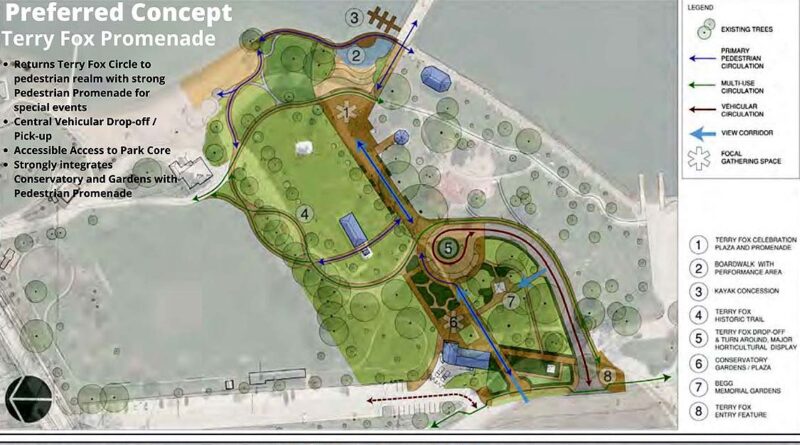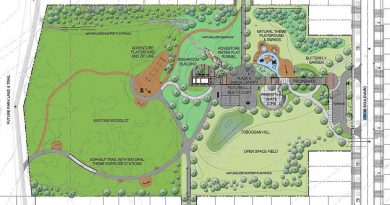Analysis: Is This The Park You Want?
By John Swartz
Monday evening council debated the merit of a proposal to remake Terry Fox Circle drafted by consultants Fleisher Ridout Partnership with Brad Fleisher in attendance by video.
Two versions of a vision were presented, a preferred (by staff) and an alternate. In the end council made a decision to defer a decision pending public input. The Reason? Four councillors were opposed to the designs.
![]()



Councillor Mason Ainsworth lead discussion asking how proposal to extend the boardwalk past the beach area next to the government dock would not affect the beach.
“It mentions in there a boardwalk with a performance area; what we’re looking at today in the concept, I’m just curious what we are going to be deciding on today. With having a boardwalk on the water doesn’t that take up space where a beach would be, or am I somehow confused on that,” Ainsworth said.
John McMullen, the City’s manager of park planning and development responded.
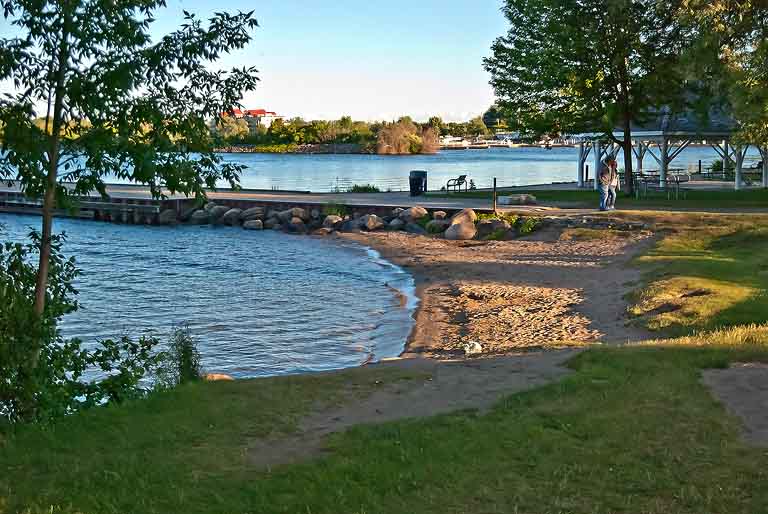
“The board walk as it currently exists leads you to the government pier, would be extended over water, so there would be an opportunity to extend the boardwalk over water and connect it to the beach so it would bisect and sort of create an internal harbor in that beach area, but the concept wouldn’t remove any of the swimming opportunities, it would sort of frame them in.”
Try throwing a stick for Rover to chase through supports for a boardwalk flyover, or getting a running start to a great belly flop. Try as I might, I cannot conceive of how building a boardwalk extension over the water does not wreck the only beach/waterfront area people and pets can use as they please. Then McMullen added a new wrinkle as to why a boardwalk, which did not appear on any other concept drawings in this manner, is now in the mix.
“The details need to be sorted out in terms of its height and have an arc in it to allow the kayaks to move back and forth. In terms of this project, this project is really the first phase of this entire area of the park, it is for the work associated with the Terry Fox Circle, its footprint where it exists today and for the implementation of new pedestrian pathways and the new driveway and turning circle alignment.”
Kayaks?
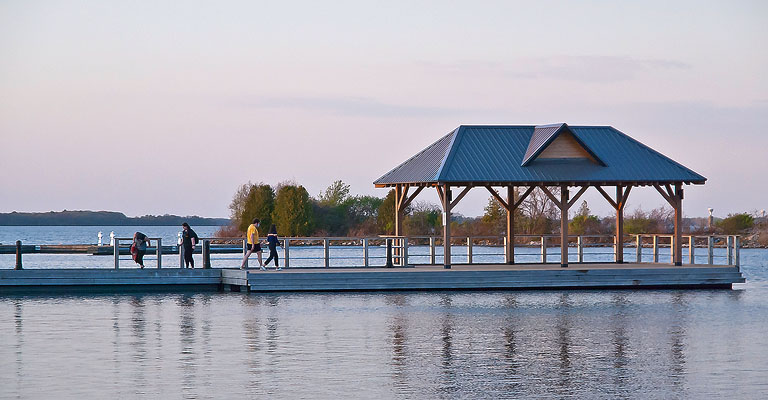
The City just spent money on a new pier/dock at the foot of Mississaga Street for launching Kayaks. Various proposals have located a kayak rental hut as part of development plans in the area of Centennial Park north of the port. Later in the debate, in response to counicllor Ralph Cipolla’s comments and questions, McMullen provided more detail about why we need two kayak points of entry in the park.
“Right now there’s a local entrepreneur business man who runs a kayak business off that existing beach. He wheels the kayaks down on a large wagon he constructed himself,” said McMullen. “That’s really where the term kayak beach, kayak access came from, it’s from the activity that happens there.”
So now we have a business operating in the park getting concessions from the City, concessions to build something beneficial to the business and sacrificing a popular swimming spot in order to duplicate a service already in existence. That ‘activity that happens there,’ is so relatively new, this writer who regularly frequents that part of the park on his hobbles along the boardwalk has never seen it in operation. Equating this new function to the long history of people being able to drive by the lake and maybe pull in close by and walk in that area as being of equal importance is disingenuous.
“When we constructed the new fishing pier (at the foot of Mississaga), we put in a kayak launch out on the dock and we are looking more into that area Veterans Park because vehicular access is easier there, so that’s where we would anticipate more of the activity of bringing your own kayak and canoes to the park would happen and the concession stand that exists at the smaller beach near Terry Fox Circle would be continue to operate as it does now, There would be no differences, it’s not relying on vehicles.”
Hehn Upset
Councilor Pat Hehn then jumped in with a visibly emotional assessment of what was presented.
“The original motion was to have (staff) report back to council with an evaluation of three design options, including one to have the Terry Fox Circle remain open to vehicular traffic with accessible parking spaces and a dedicated drop off spot in close proximity to the beach area and my report only shows two options and neither of them have the Terry Fox Circle remaining open,” Hehn said. She hit the main points of objection well, so we’ll run with the majority of what she said.
“When I agreed to vote for the whole park master plan I did so with trepidation. At that time I had major concern about the Terry Fox Circle being closed off and I voiced my concerns at that time. I was told ‘not to worry’ I would have the opportunity later on to address those concerns and it was not a done deal. I feel I was lead down the garden path, so to speak, and here was never any intention to of having the Terry Fox Circle left open. I feel betrayed,” she continued.
In general she objected to a change in perception of what Couchiching Beach Park is from a passive, un-programmed bit of green on the waterfront, to a concept that seeks to make it a place for events and activities to happen.
“The Art in Public Spaces committee recommends peripheral parking that is wheelchair and walker accessible along with walking paths that lets everyone to come close to the horticultural displays and artwork that will be part of the redesigned space. That is not the purpose of Couchiching Park, nor should it be. It is a people park, where people can gather to picnic, swim and throw a Frisbee and just relax. The reason we need the Terry Fox Circle open is so that those with disabilities can also enjoy all the park has to offer”
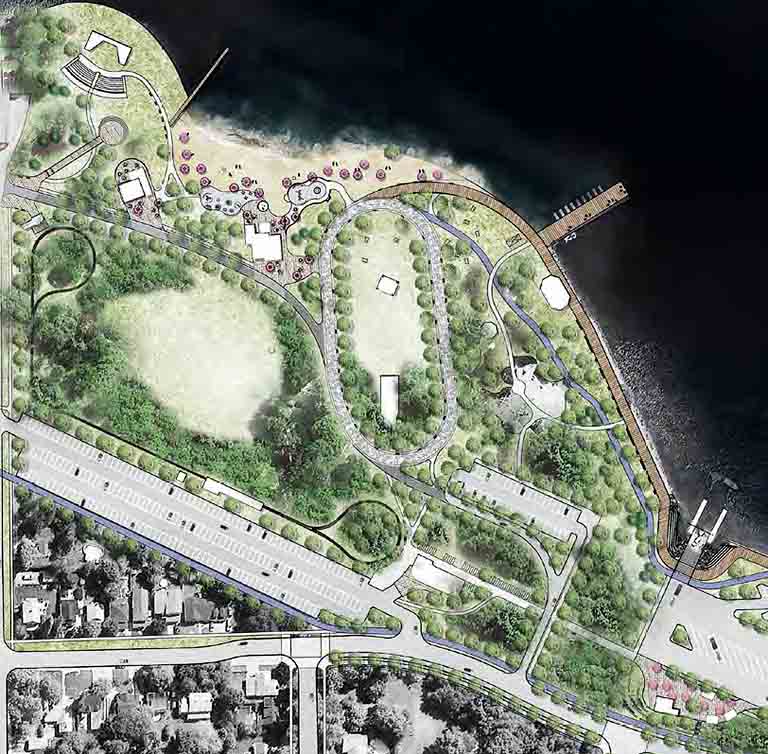
Staff took peripheral parking to an extreme. The Downtown Waterfront Parkland Design Study council adopted last October and which drove the development of what was presented this week quite clearly shows a new parking lot west of the playground with 44 spaces meant to replace 36 or so parking spaces which would be lost if parking was removed from the circle. Instead this design repurposes additional parking in an expanded lot on the western fringe of the park (the one that empties out onto Jarvis Street, also shown in diagram) which was intended to generally increase parking for the whole park when events like the Scottish Festival happen and calls it acceptable. The fact the parking in this plan is even further from the waterfront, the beach, the pavilion and the playground then the one in October’s plan was not noticed or commented on by anyone.
Compound the distance by the fact the hard surface of the Circle would be ripped out and replaced by turf makes it quite a trek for those with mobility limitations and herding kids.
“I know a number of seniors simply could not use their walkers to go through the park and I’m here to tell you that I would not be (?) while pushing a wheelchair. We must remember that not all wheelchairs are electric,” Hehn said. Then she got into the details of the written report. She like many, including this writer’s recollection of the discussion in January when council authorized staff to come back with three designs, was under the impression the drive would be moved further away from the water’s edge, not taken out all together.
“Under project objectives there are listed the following: redefine circulation routes to the site for traffic movement and go back to the need for deactivated traffic. Did anyone look at a way to make it safe for cars to get close to the lake, possibly widening the road at that spot, putting in a sidewalk? It seems to me it was simply ignored.”
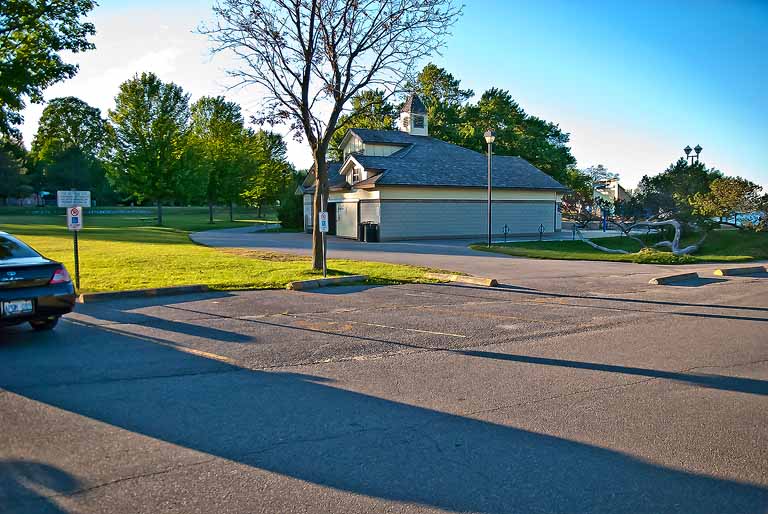
“Parking moved to a safer location; I have no problem with the majority of parking being moved to a safer location. I only asked there be some handicapped parking being left where it is now.”
Another aspect she took issue with is in step with changing the function of that part of the park.
“Enliven Terry Fox Circle to allow for more public art and historical storyboards, and horticulture displays; I have been on record as being a great supporter of public art, however I believe there is a proper place for everything and I am not sure that Couchiching Park is big enough to support to support any type of a sculptural garden. I believe it is more of a passive park, place where people can go to relax and be with their family. Public art can certainly be in Centennial Park at the entrance to the trails, or many other places in our community. I recognize we may need to put up some story boards in Terry Fox Circle at some point, but that should be the extent of it.”
The story boards idea was talked about as a way of explaining the Champlain Monument, if it ever returns. She has a point, it is not secret this publication supports more art in more places, and certainly some art could be placed in that part of the park, but it seems Hehn is operating with more information than I because the scale of a sculpture garden would not be in keeping with the park as it is used now.
She closed her opening salvo out expressing her displeasure.
“There were citizens who expressed their valid concerns about the Terry Fox Circle being closing to vehicular traffic when this came forward originally. Unfortunately their input was not included, so we do not have the luxury of reading what they had to say. This is a family park, a park for all Orillians to use and enjoy. It was never intended to be used as a special events park. I am profoundly disappointed in this report. I expected better. At the very least, I expected to be listened to and my concerns acknowledged,” Hehn said.
Are Cars The Only Problem?
There is no doubt there is a faction in Orillia who don’t like cars, especially anywhere near parks, and those same people think everyone is as able bodied as they are. That many of those people work for the City is disappointing. Far too often concerns about distance are dismissed by those who can do the walking, which is insulting to those who can’t but still want to be part of the community. Several times proposals have been floated that drastically reduce parking at the waterfront, ignoring people are lazy, in that lugging beach and picnic gear and keeping track of children while crossing uneven fields is not something they want to do.
Many people also drive from their homes which are further away than nearby neighbourhoods to attend community events like Rotary/Lions Funfest, Canada Day and the various events the chamber holds. It seems like only at parks is parking taboo. The City just built a huge parking lot at the Orillia Recreation Centre so people can drive there in order to partake in exercise and swimming and no one has voiced objections it takes up too much green space. At the very same meeting council authorized installing electric vehicle charging stations in that parking lot. Council has also bent over backwards many times to put handicap parking in many places, but some councillors discount this consideration, or the needs of those who are not able to walk, when it comes to parks, particularly those on the waterfront.
Much has been made of the perception the circle is akin to Barrie Speedway with drivers not paying any attention to people walking. It is helpful to recall about 15 years ago the City created a bottleneck by putting in a bike lane on the roadway. There are concrete parking bumpers installed to separate the bike path from the drive path.
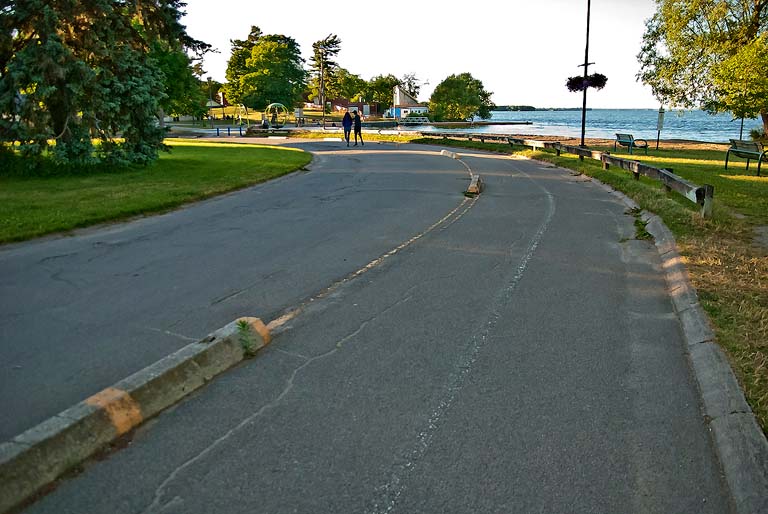
Here’s the thing about our bike paths, people walk on them, irresponsibly and quite oblivious they are on a bike path. Walkers act surprised, and complain when overtaken from behind by people on wheels (which includes rollerblades, electric chairs and E-bikes). Council has had a few discussions stemming from complaints about the later, you can’t hear E-bikes approaching from behind, and somehow it’s the biker’s responsibility to make their presence known on a facility meant for them.
At the lower part of the circle near the water, I have observed many instances of walkers jumping out of the way in surprise onto the drive path when overtaken by a bike that should be expected to be there, and of bikers suddenly cut off by walkers not paying attention and veering into the open space bikers were aiming for and not having anywhere to go because of the bumpers. It seems to me this is the heart of the issue people have with cars on the circle, they are getting out of the way of the bikes and into the way of passing cars – and then it’s the car driver’s fault people jumped out in front of a car. We were taught in school to walk against traffic on roadways where sidewalks are absent, and the same applies to the bike path because its hard sneak up to someone from the front.
On the safety issue Cipolla sided with comments councilor Jay Fallis made previously.
“I asked the police a little while back, “has there been any accident there, any kids hit, anything else?” They could not find anything, so I think the safety factor you are alluding to doesn’t exist. I think people are very cautious, the speed bumps Jay was talking about creates a very slow pace in there,” Cipolla said.
“There has not been any fatalities or police involvement in significance. What we do hear – in the parks division and from people – is about near misses and with cyclists and children and cars, particularly closest to the lake where they are all forced onto the same pathway. Although there hasn’t been a fatality there have been plenty of phone calls to the City asking us to address what has been perceived as, and is, a significant safety issue,” McMullen replied. So instead of admitting the City shoehorned something into a space it doesn’t fit and didn’t do it properly, they blame car drivers.
Continuing with Cipolla’s comments, he read parts of two letters on the matter he received. One stated:
“The circle has been there for over 110 years. Is this the council that will be known for destroying our park? Leave it alone.” The other, “Being able to drive a visitor or severely handicapped individual around the circle and see the lake lets them feel human and makes them happy.”
He then did some crystal ball gazing.
“I don’t think this will go through budget until 2022, which will be after the next election, so the next council will be able to turn this around. Please let’s not make the mistake. Let’s work out a way we can leave the circle as is, so all the renovation that goes with it, the pedestrian, the cycling and everything else around it, but leave people to drive and a parking area. And for people to go and bring their baskets to the pavilion when its booked – and we book that pavilion for different groups, for different groups to have their meetings, how you bring the food into there is unbelievable.”
Which raises another point. The pavilion is often rented to large gatherings, usually there is food involved, lots of food. Someone has to get the food to the pavilion, which will now be a harder task if access and parking is removed to the furthest point it can be removed to. Cipolla offered an alternative which should have been part of the mix and in keeping with what many councillors and people who follow along thought was going to happen. He suggested rerouting the circle to go around closer to the Champlain monument instead of around the pavilion as the alternative design shows.
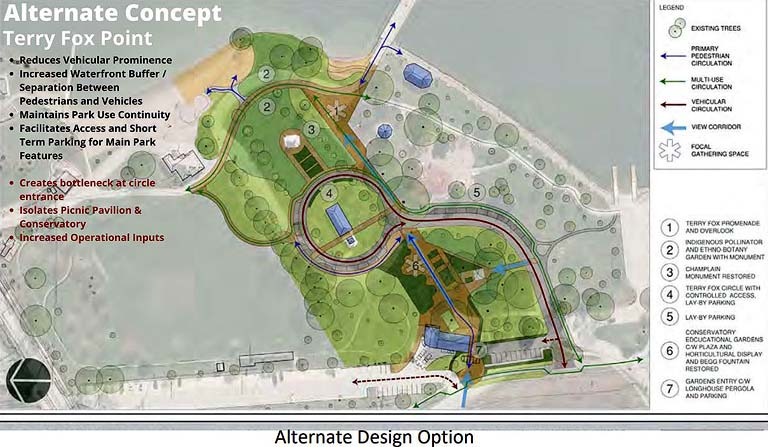
The preferred design was characterized as simply removing cars from the circle. In fact, and the drawing shows it, the circle will be removed. Cipolla said he this would impair the ability of police to patrol and for emergency responders to get to the immediate waterfront area.
“The other questions I have is, emergency vehicles having quick access to the waterfront where accidents do happen, as we all know just recently, not being able to have quick service to get there immediately. The circle, whether it’s the alternative option or preferred option will not allow that to happen. I will not support either option,” Cipolla said. McMullen said the further away access point for vehicles at Jarvis Street near the Aqua Theater is available.
Thinking ahead to the colder season, how will the fire trucks, emergency vehicles and buses get staged for the annual Polar Bear Dip if there is no way to get them to the staging area, or out. Backtracking in the discussion to Fallis’s comments, he hit on the boardwalk surprise and driving.
“I think I’d be inclined to vote against, there’s a couple of different reasons but one of them is the boardwalk going over the beach. It does kind of eliminate that natural element. I don’t think that’s kind of the direction, as Pat was mentioning, you want more of a passive approach,” Fallis said.
“On the car access, I went a little bit back and forth on this because I do recognize there’s the environmental benefit to reducing car traffic, but at the same time there’s this accessibility element to it. Seniors really look to Couch Beach Park as this beautiful opportunity to go around and take it all in and it is unique to have that in a park. I don’t believe Option 1 looked seriously at that. I know there are some safety concerns, I believe there’s way’s of mitigating them, like changing how the driveway would work, narrowing the lane, the option as well, speed bumps, there’s a million different things. The other thing you could do is have, as we kind of have now, you’ve got a driving space and there’s time it’s not drivable and it’s more pedestrian access. I think you could have featured that more in the park design. I think that would have been maybe a better approach to it.”
What Fallis may have been referring to with his latter point is the City already closes car access to the circle when major events are on because of the greater numbers of pedestrians and too many children running around. This makes absolute sense and we would have problem if the City didn’t do this. Fallis also doesn’t support the alternative option and wants the whole thing reviewed and brought back.
“This is Orillia’s park, it’s everyone’s park and I think that accessibility element is really important ensuring the seniors in our community have the same type of access we all do,” Fallis said.
Kloostra – Plan Limits Access
Councillor Rob Kloostra was also not keen on the design. He wanted to know why the committees most likely to have opinions on the project did not have representation in the report.
“This is a major infrastructure project that was brought to the rec advisory committee and the active transportation committee, yet they provided no comment,” Kloostra said.
“The Terry Fox Circle is an integral part of the residents and visitors to the City of Orillia. Do we want to be known as the City that said, “remember when you could drive through the park?” If we take away that, things they are used to, they’ll just stay home. If we deny access to an area which people take pleasure in driving around, if you are asking for enhancements, adding more places to sit, or pavilions, let’s look at that. Parents of young children will not visit with a vanload at the drop off area if it’s just going to be a kiss and ride to go there for the day.”
“The Centennial drive plan already takes away an exit from the boat launch. We have not even explored the 40 temporary slips at the port and the chamber of commerce. If we keep limiting access to the Jewel of the Trent as we advertise to visitors and the general public people will just drive by Orillia and never return. Do we have an economic study as to what the negative effects of these changes will have, changing Terry Fox Circle?”
Emond In Support of Plan
Then Councillor Ted Emond spoke in favour of the preferred design.
“This council and the last one have been considered in this community to be some of the most progressive councils we’ve had in our city in many years. We have now received two reports on this park that suggest there is a future for the park taking into account the current concerns with safety and the growing population, so we are making a decision, not for today’s people, we’re making a decision for those folks in Orillia for the next 50 years. My view is that things change over time,” Emond said. “This design I think is a perfect blend of what the original proposal suggested, which was to remove the conflicts that exist in the park. There’s a couple diagrams that show how this in fact does remove those conflicts, but at the same time provides us seniors with the ability to get into the park and to participate in the park activity.”
“I can appreciate there are a few people in our community who are aging who like to drive by, but if we change that now, ten years from now we won’t get any complaints about this at all because it will become the norm, it will become a new way of thinking about the park.”
“I believe it’s a small group of people in our community who crave the status quo, crave looking into the rearview mirror.”
“I am more than willing to put forward the option because I think it’s a good one, it’s a well-thought through one, I think it’s one based on the science and art of landscape architecture and I commend Brad and his team for coming up with this and John for bringing it forward.”
Lauer Has Different Idea
As usually happens with contentious issues, councillor Tim Lauer approached the issue form a different angle and offered a sensible path.
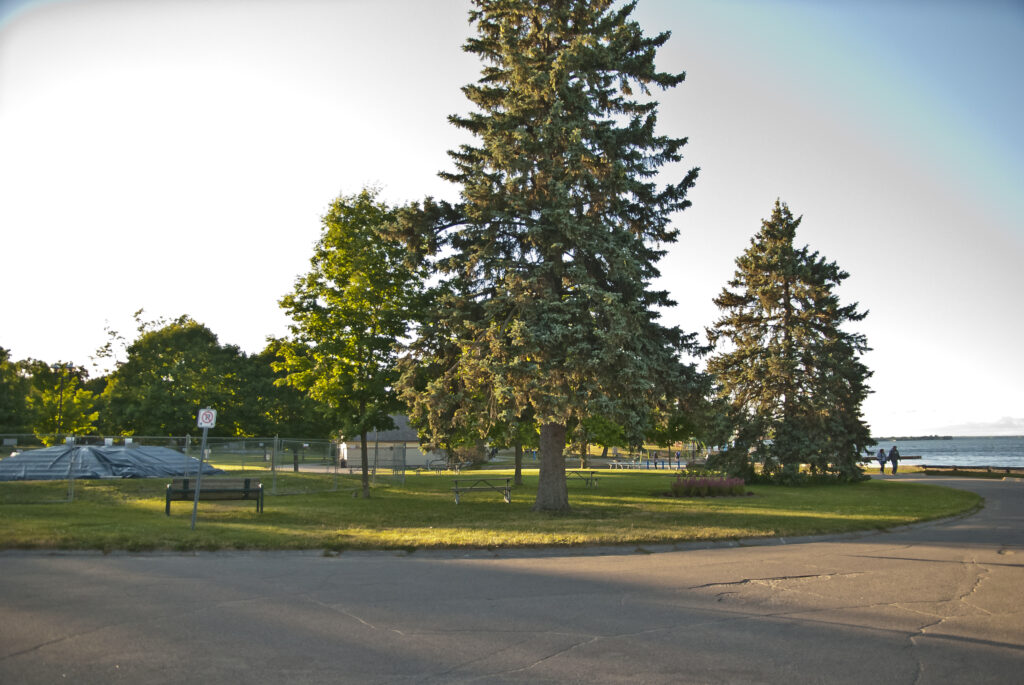
“My concern here is simply the public. I’m sympathizing with the few people who envision solving the safety issue by simply moving the circle off of the beach and bringing it closer to the monument or something like that, so I understand there were people who were thinking along those lines. I also think when you are looking for reactions from people you don’t really get it until you tell them what you are going to do, so that initial 70%, I’m pretty sure if you had announced you were going to close Terry Fox Circle that you would have got as much comment the other way,” Lauer said.
“I’m just wondering what a process might be to let this simmer in the public’s domain for a short while before any decision was made, if we defer this and let these two designs stand, of course people will always have Option 3; could we do that for perhaps the July meeting and decide which one you want to push forward to budget. My fear would be if we rushed ahead and put a stamp on something, especially if it turns out you get a 5/4 vote or something like that and we go to all the trouble of designing it and then it gets to budget and people have really got an earful and we abandon the project because that’s out only option. So I’m wondering if there may be an avenue to have a little bit more discussion on this so that all of council might feel more comfortable.”
A few things, Lauer is referring to data in the October plan’s study findings which indicated 70% of respondents wanted to reduce traffic in the park. He correctly points out reducing and removing are not the same things. He is correct in his assessment of how people react to plans council approves when it directly affects them. Time and again people come out of the woodwork when confronted with change they didn’t see coming. Staff pointed out there were public consultations (how they arrived at the 70%) and drawings have circulated. On the latter there have been drawing available, but not the one presented to council on Monday. This came up again later when some commented about not knowing the drawings had been out. They weren’t, or readers of SUNonline/Orillia would have seen them. There has been no opportunity for public comment on these most recent and radically different drawings than there was for drawings previously available.
Mayor Steve Clarke, who favours the preferred design, countered Lauer’s desire to have more input.
“We do that kind of thing, you generally hear people that are against something that’s coming out, how would you suggest getting people to give us an objective response to this?” Clarke asked. Councillor Ainsworth also asked a similar question later in the meeting. Lauer who in the past has expressed the idea of removing traffic from parks countered with the idea there will be feedback on both sides
“If you put your plan on the table, you of course (get) people who don’t want it closed and don’t’ agree with you, you are going to hear form (them), but there’s lots of people in this town who do believe that should be shut down,” Lauer said. “I’m thinking you’ll get a much more balanced discussion than what has happened to date.”
As he has pointed out many times, there is a big difference in opinion received when things are at the idea stage versus when actual drawings and concepts are produced. The most recent example is regarding the Elgin Street pumping station; that it was going to be rebuilt near the old one was not a secret and things proceeded without too much objection – until people saw the drawings of its location. What is happening now is staff and some members of council are relying on old data for a different set of circumstances.
![]()



![]()
Lauer moved to defer a decision until the July council meeting. This prompted questions of staff and the consultant about how this would affect timelines to be able to bring it to budget. McMullen said a formal public input exercise would likely delay things for a year. Lauer said people have the ability to reach each councillor by phone, email or in person and this would inform their individual decisions without the need to have a formal public input format. Both McMullen and Fleisher said if that was the case waiting until July for a decision would not adversely affect timelines – unless major change was to be incorporated. Councillors Cipolla, Fallis, Hehn, Kloostra and Lauer voted to defer.
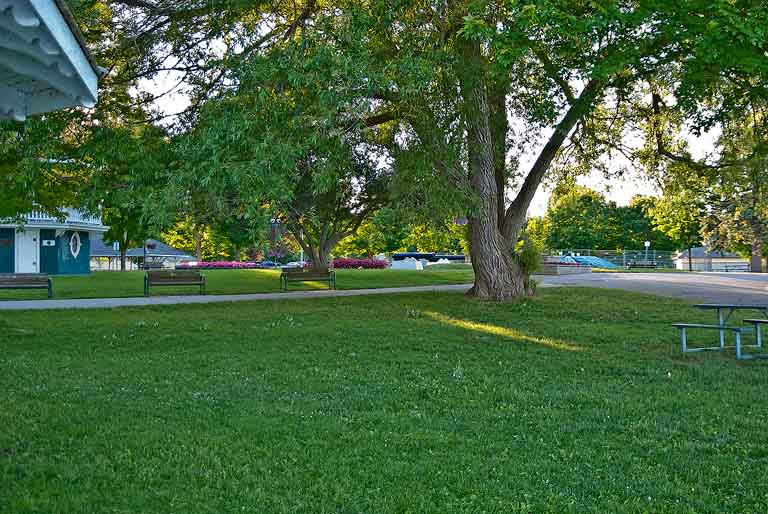
I believe what people would find acceptable of is to redo the road way with paving stones. This would say to drivers, this area is different than a road and would make walking easier than on the uneven and broken asphalt as it is now, or over a grass field as proposed. I have been opposed to tons of concrete and paving stones replacing grass in the past, but in this case it makes sense – and grass is not being replaced. Much was made of creating an event/performance space in the area of the cannons (which are not accounted for in the new drawing, the garden as well) and bandstand down to the boardwalk and the second pavilion, ignoring the lay of the land which has a slope toward the water. We have an event space in the park called the Aqua Theater, and the plaza at the port, and we want a civic square built at Mississaga and Centennial as part of the redevelopment project there, spending money on another one does not make things better, especially on a bit of land unsuitable for it.
Bottom line, people are objecting to removing Terry Fox Circle and car access for many good reasons, It is not good look to not take them into account whether its 30%, or 10% who want access maintained. They live here too and deserve to be able to enjoy their park without placing conditions on them. And, when half of council doesn’t like a plan, and it is not good enough to convince 6 or 7 councillors, its time to go back to the drawing board.
(Photos by Swartz – SUNonline/Orillia; Images Supplied) Main: Terry Fox Circle redevelopment preferred design.

